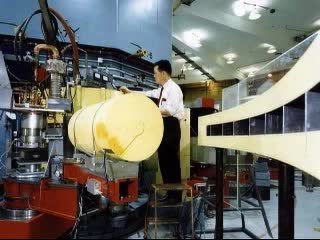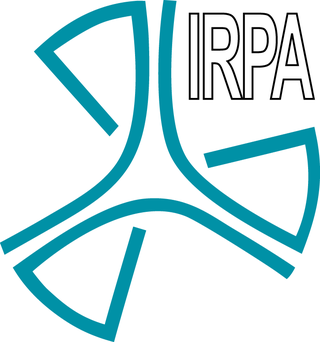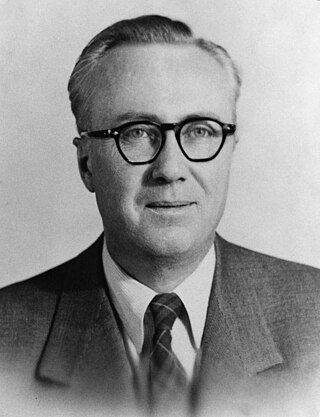Related Research Articles

The sievert is a unit in the International System of Units (SI) intended to represent the stochastic health risk of ionizing radiation, which is defined as the probability of causing radiation-induced cancer and genetic damage. The sievert is important in dosimetry and radiation protection. It is named after Rolf Maximilian Sievert, a Swedish medical physicist renowned for work on radiation dose measurement and research into the biological effects of radiation.
Medical physics deals with the application of the concepts and methods of physics to the prevention, diagnosis and treatment of human diseases with a specific goal of improving human health and well-being. Since 2008, medical physics has been included as a health profession according to International Standard Classification of Occupation of the International Labour Organization.
Radiation dosimetry in the fields of health physics and radiation protection is the measurement, calculation and assessment of the ionizing radiation dose absorbed by an object, usually the human body. This applies both internally, due to ingested or inhaled radioactive substances, or externally due to irradiation by sources of radiation.

Health physics, also referred to as the science of radiation protection, is the profession devoted to protecting people and their environment from potential radiation hazards, while making it possible to enjoy the beneficial uses of radiation. Health physicists normally require a four-year bachelor’s degree and qualifying experience that demonstrates a professional knowledge of the theory and application of radiation protection principles and closely related sciences. Health physicists principally work at facilities where radionuclides or other sources of ionizing radiation are used or produced; these include research, industry, education, medical facilities, nuclear power, military, environmental protection, enforcement of government regulations, and decontamination and decommissioning—the combination of education and experience for health physicists depends on the specific field in which the health physicist is engaged.

The linear no-threshold model (LNT) is a dose-response model used in radiation protection to estimate stochastic health effects such as radiation-induced cancer, genetic mutations and teratogenic effects on the human body due to exposure to ionizing radiation. The model statistically extrapolates effects of radiation from very high doses into very low doses, where no biological effects may be observed. The LNT model lies at a foundation of a postulate that all exposure to ionizing radiation is harmful, regardless of how low the dose is, and that the effect is cumulative over lifetime.

Radiation hormesis is the hypothesis that low doses of ionizing radiation are beneficial, stimulating the activation of repair mechanisms that protect against disease, that are not activated in absence of ionizing radiation. The reserve repair mechanisms are hypothesized to be sufficiently effective when stimulated as to not only cancel the detrimental effects of ionizing radiation but also inhibit disease not related to radiation exposure. It has been a mainstream concept since at least 2009.
The rad is a unit of absorbed radiation dose, defined as 1 rad = 0.01 Gy = 0.01 J/kg. It was originally defined in CGS units in 1953 as the dose causing 100 ergs of energy to be absorbed by one gram of matter. The material absorbing the radiation can be human tissue, air, water, or any other substance.
The International Commission on Radiological Protection (ICRP) is an independent, international, non-governmental organization, with the mission to protect people, animals, and the environment from the harmful effects of ionising radiation. Its recommendations form the basis of radiological protection policy, regulations, guidelines and practice worldwide.
Radiobiology is a field of clinical and basic medical sciences that involves the study of the action of ionizing radiation on living things, especially health effects of radiation. Ionizing radiation is generally harmful and potentially lethal to living things but can have health benefits in radiation therapy for the treatment of cancer and thyrotoxicosis. Its most common impact is the induction of cancer with a latent period of years or decades after exposure. High doses can cause visually dramatic radiation burns, and/or rapid fatality through acute radiation syndrome. Controlled doses are used for medical imaging and radiotherapy.
The collective effective dose, dose quantity S, is calculated as the sum of all individual effective doses over the time period or during the operation being considered due to ionizing radiation. It can be used to estimate the total health effects of a process or accidental release involving ionizing radiation to an exposed population. The total collective dose is the dose to the exposed human population between the time of release until its elimination from the environment, perhaps integrating to time equals infinity. However, doses are generally reported for specific populations and a stated time interval. The International Commission on Radiological Protection (ICRP) states: "To avoid aggregation of low individual doses over extended time periods and wide geographical regions the range in effective dose and the time period should be limited and specified.
David A. Schauer, ScD, CHP, is Executive Director Emeritus of the National Council on Radiation Protection and Measurements (NCRP). During his tenure a number of updated and new publications were issued by the Council.

The roentgen or röntgen is a legacy unit of measurement for the exposure of X-rays and gamma rays, and is defined as the electric charge freed by such radiation in a specified volume of air divided by the mass of that air . In 1928, it was adopted as the first international measurement quantity for ionizing radiation to be defined for radiation protection, as it was then the most easily replicated method of measuring air ionization by using ion chambers. It is named after the German physicist Wilhelm Röntgen, who discovered X-rays and was awarded the first Nobel Prize in Physics for the discovery.

Radiation dose reconstruction refers to the process of estimating radiation doses that were received by individuals or populations in the past as a result of particular exposure situations of concern. The basic principle of radiation dose reconstruction is to characterize the radiation environment to which individuals have been exposed using available information. In cases where radiation exposures can not be fully characterized based on available data, default values based on reasonable scientific assumptions can be used as substitutes. The extent to which the default values are used depends on the purpose of the reconstruction(s) being undertaken.

The Society for Radiological Protection is the leading UK professional body promoting learning and skills in the field of Radiological Protection. The Society was formed in 1963, and received its Royal Charter in 2007. It has the overall objectives of improving public knowledge and maintaining professional standards in that field. It is the largest society of its kind in Europe, and second largest in the world.

The International Radiation Protection Association (IRPA) is an independent non-profit association of national and regional radiation protection societies, and its mission is to advance radiation protection throughout the world. It is the international professional association for radiation protection.
Xie George Xu was the Edward E. Hood Chair Professor of Engineering at Rensselaer Polytechnic Institute (RPI), Troy, New York, United States, before he relocated in 2020 to China and joined the faculty of the University of Science and Technology of China.

Leonidas D. Marinelli was the American radiological physicist who is best known for founding the field of Human Radiobiology and developing the Marinelli Beaker.

Lauriston S. Taylor was an American physicist known for his work in the field of radiation protection and measurement.

Dade Moeller was an internationally known expert in radiation safety and environmental protection.

Flight-time equivalent dose (FED) is an informal unit of measurement of ionizing radiation exposure. Expressed in units of flight-time, one unit of flight-time is approximately equivalent to the radiological dose received during the same unit of time spent in an airliner at cruising altitude. FED is intended as a general educational unit to enable a better understanding of radiological dose by converting dose typically presented in sieverts into units of time. FED is only meant as an educational exercise and is not a formally adopted dose measurement.
References
- 1 2 Jasso, Laura (Fall 1999). "UTEP's Distinguished Alumnus for Professional Achievement John Boice Jr.", pp. 4–5. The Nova Quarterly
- 1 2 Brent, John L. (2009). "Introduction of John D. Boice Jr, The 2009 Taylor Lecturer Archived 2015-09-28 at the Wayback Machine . National Council on Radiation Protection and Measurements
- ↑ Harvard School of Public Health. 2008 Alumni Award of Merit winners: John Dunning Boice, Jr., SM '74, SD '77
- ↑ "VBDR.org: Veterans' Advisory Board on Dose Reconstruction, Veterans' Dose Reconstruction Program". vbdr.org. Retrieved 5 June 2014.
- ↑ "R.S. Landauer, Sr., Lecture Series". hps.org. Retrieved 5 June 2014.
- ↑ Johnston, Thomas P. (23 February 2007). "Greater New York Chapter of the Health Physics Society". Thomas P. Johnston. Retrieved 25 June 2014.